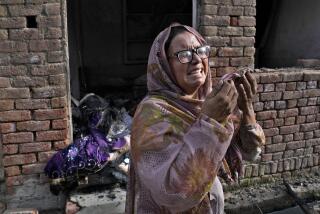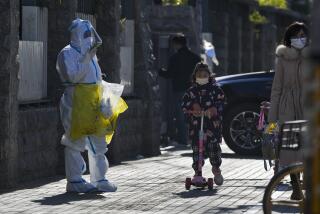Police Keep Uneasy Vigil After Ethnic Riot in China
- Share via
BEIJING — Thousands of police maintained an uneasy vigil over a town in central China early today after seven people were killed in a riot pitting minority Hui Muslims against the majority Han Chinese.
Martial law was imposed on Langchenggang in Henan province and 18 people were arrested amid five days of violence that ended Sunday, the government said. Everything “is now under control,” authorities said in a statement carried by the state-run New China News Agency.
The exact cause of the violence remained sketchy, and it took several days for word of the incident to leak out.
Associated Press reported that the fighting began after three Hui men in a car beat up a 17-year-old Han boy who blocked the street. The confrontation escalated until a group of 400 to 500 Hui came from a nearby town and large-scale clashes took place. Three local residents reached by the Los Angeles Times by telephone gave variations of the blocked-car story. All of them declined to give their names for fear of getting in trouble with authorities.
Other reports said the uprising erupted after two vehicles collided. The New York Times, which first reported the story, said the incident was sparked by a traffic accident in which a Muslim taxi driver hit and killed a 6-year-old Han girl.
Xing Fengwu, a resident of nearby Kaifeng city, said thousands of police were sent from there into Langchenggang to quell the violence. All public transport was halted for several days in the area and schools were shut down Saturday and Monday, another resident said by phone.
China’s media remained mum on the issue until late Monday, when the government news agency confirmed the clashes and said they had led to seven deaths and 42 injuries.
The delay was not unusual given the Communist Party’s tight grip on the media and its extreme sensitivity about any issues linked to social conflict.
“Everybody’s talking about it. It’s a huge incident,” said a woman at a tourism agency in nearby Zhengzhou, the provincial capital, who would only give her surname, Liu. “There’s no press release, no official reports, no media coverage, only rumors flying around. People say it got pretty bloody.”
Han Chinese make up more than 90% of the nation’s 1.3 billion people. The Hui minority are ethnic Chinese whose ancestors converted to Islam.
The Henan region has a history of ethnic confrontation, said Zhang Xingshui, a Beijing-based attorney specializing in social and human rights cases. Dozens of minority communities migrated to China centuries ago from Central Asia, many traversing the Silk Road, and settled in a central belt stretching through parts of Henan, Shanxi and Gansu provinces.
They unite in the face of the Han majority, Zhang added, and are quick to defend one another in a confrontation.
Several officials in local police and propaganda offices declined to comment on the clashes.
“I’ve just gotten a promotion. If I say anything, I’ll lose my job,” said one official in Zhengzhou.
Xing, the Kaifeng resident, said he had seen several similar clashes in the area over the years, including one in 2002, in which three people were killed. “It doesn’t take much to spark these,” he said.
Experts said this weekend’s riot and others like it underscored the tensions lurking just below the surface in the world’s most populous country.
“China’s social development has lagged far behind its economic development,” said Zhong Dajun, director of the Beijing Dajun Center for Economic Analysis and Studies. “These sorts of culture clashes signal real problems.”
In particular, he said, Chinese enjoy competition and choices in their economic lives but lack choices in their political and social lives, creating a disconnect.
“The old ideological system is broken but the new one is not yet established,” Zhong said. “Without greater democracy, there will surely be increased confrontation.”
Yin Lijin in The Times’ Beijing Bureau contributed to this report.
More to Read
Sign up for Essential California
The most important California stories and recommendations in your inbox every morning.
You may occasionally receive promotional content from the Los Angeles Times.










